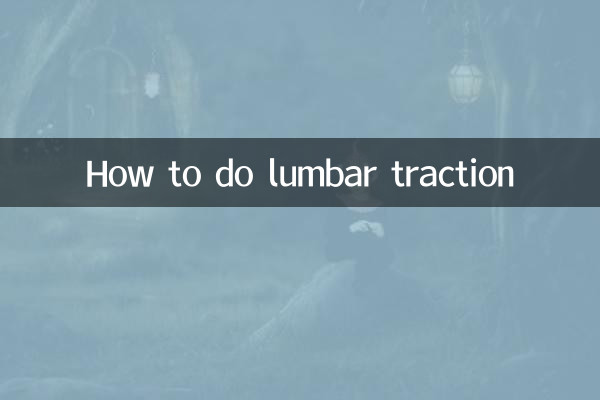How to do lumbar traction
In recent years, with the popularization of living habits such as sitting for long periods of time at work and lack of exercise, lumbar spine problems have become a health problem for many people. Lumbar traction, as a common physical therapy method, has attracted much attention. This article will introduce in detail the principle, applicable groups, operation methods and precautions of lumbar traction, and attach the hot topics and hot content data of the entire network in the past 10 days to help readers fully understand this therapy.
1. Principle of lumbar traction

Lumbar traction uses external force to stretch the lumbar spine, reduce intervertebral disc pressure, and relieve nerve compression, thereby improving symptoms of pain and limited activity. Its principles mainly include:
| Principle | function |
| mechanical stretching | Open the intervertebral space and reduce the pressure on the intervertebral disc |
| Improve blood circulation | Promote local blood circulation and relieve muscle spasms |
| nerve decompression | Reduce nerve root compression and relieve pain |
2. Applicable groups for lumbar traction
Lumbar traction is not suitable for everyone, and the following people may benefit from it:
| Applicable people | Symptoms |
| Patients with lumbar disc herniation | Low back pain with radiating pain in lower limbs |
| Patients with lumbar degenerative disease | Chronic low back pain, limited mobility |
| Some patients with lumbar spinal stenosis | intermittent claudication |
3. Operation method of lumbar traction
Lumbar traction can be divided into two methods: professional traction in the hospital and simple traction at home:
1. Hospital professional traction
| steps | Operating Instructions |
| Assessment check | The doctor evaluates the condition and determines the traction plan |
| Equipment preparation | Use a professional traction bed and set parameters |
| implement traction | Gradually increases traction for 15-30 minutes |
2. Simple towing for families
| method | Operational points |
| suspension traction | Use door frames or horizontal bars to let your body hang naturally |
| Traction by dead weight | Lie on your back, bend your knees, and stretch slowly |
| Instrument assistance | To use a household leash, follow the instructions |
4. Precautions
When performing lumbar traction, special attention should be paid to the following matters:
| Things to note | Description |
| Taboo groups | It is contraindicated in patients with osteoporosis, lumbar fractures, and acute inflammation. |
| Velocity control | Take it step by step and avoid excessive pulling |
| duration | No more than 30 minutes at a time, 1-2 times a day |
| Abnormal reaction | Stop immediately if severe pain or discomfort occurs |
5. Popular health topics on the Internet in the past 10 days
According to data analysis across the entire network, hot topics related to lumbar spine health in the past 10 days include:
| Ranking | topic | heat index |
| 1 | Office lumbar spine exercises | 9.2 |
| 2 | Self-healing methods for lumbar disc herniation | 8.7 |
| 3 | Smart traction equipment review | 7.9 |
| 4 | Traditional Chinese Massage vs Western Medicine Traction | 7.5 |
| 5 | Prevention of Lumbar Spine Problems in Teenagers | 6.8 |
6. Expert advice
1. Before traction treatment, you should consult a professional physician to clarify the diagnosis and indications.
2. Combined with core muscle group exercises to enhance lumbar spine stability
3. Maintain good sitting and standing posture and avoid staying in the same position for a long time
4. Control weight and reduce burden on lumbar spine
Conclusion
Lumbar traction, as an auxiliary treatment, can effectively relieve lumbar spine problems when used correctly. However, it should be noted that any treatment should be individualized and it is recommended to be carried out under the guidance of a professional physician. At the same time, prevention is better than cure, and developing good living habits and exercise habits is the long-term solution to maintain the health of the lumbar spine.

check the details

check the details